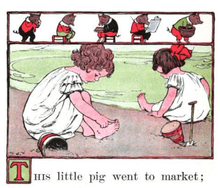Fingerplay

Fingerplay, commonly seen in early childhood, is hand action or movement combined with singing or spoken-words to engage the child's interest. According to Erikson, many children develop autonomy and "want to learn and imitate the activities and behavior of others." According to Wong's Essentials of Pediatric Nursing, "gestures precedes speech and in this way a child communicates satisfactorily."[2] From all ages children become active listeners and can control their eyes, body, and attention on the teacher.[3]
Some chants or common rhymes that incorporate fingerplay include the "Itsy Bitsy Spider", "Round and round the garden", and "This Little Piggy". The article entitled, "Fingerplay Fun" explains fingerplay as a form of chants or songs to gather the child's attention.[4] Reciting chants or stories "help him develop an ear for sounds and discover that sounds can be manipulated and changed".[3] An example of fingerplay, "Five Little Monkeys":
Five little monkeys (five fingers)
Jumping on the bed - (rest elbow on other hand, jump arm up and down)
One fell off, (hold up one finger, bring down as if falling)
And bumped his head. (hand to head)
A fingerplay is a nursery rhyme for children that uses hand movements coordinated with words to engage and sustain children's interest. Fingerplays can be in the form of songs or chants. Typical examples would be the "Itsy Bitsy Spider", "Round and round the garden", or "This Little Piggy". Teachers use fingerplays to introduce poetry to children and introduce new concepts. They can also help children develop such skills as fine motor co-ordination and following directions.[5]
In a Wee Sing movie, The Best Christmas Ever!, Susie who has special needs does some Christmas fingerplays.
References
- ↑ Wentworth. Work and Play with Numbers. p. 14.
- ↑ Hockenberry, Marilyn (2005). Essentials of Pediatric Nursing. Elsevier. pp. 87–88.
- 1 2 Miller, S (2001). "Getting Silly With Sounds". Scholastic Parent & Child. 9 (2): 29.
- ↑ Church, E. (2001). Fingerplay Fun!. Early Childhood Today, 16(1), 60-61
- ↑ Curtis, Kathleen A.; DeCelle-Newman, Peggy (2004-12-14). The PTA handbook: keys to success in school and Career for the Physical Therapist Assistant. Slack Incorporated. Retrieved 2010-07-27.